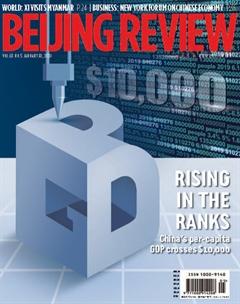EYE ON THE PRIZE
By Pan Helin
Over the past decades, China has achieved an economic growth miracle, particularly in 2019, amid global economic slowdown, sluggish international trade growth and mounting downward pressure on the global economy. Its steady GDP increase suggests expanding space for macroeconomic policy, declining debt ratio and enhancing domestic market attraction, which shows the countrys rising role in boosting the global economy.
Chinas GDP growth has been a nationwide focus. Its economic aggregate surged from 67.91 billion yuan ($9.8 billion at the current exchange rate) in 1952 to 90.03 trillion yuan($13.6 trillion) by the end of 2018, increasing by 174 times, National Bureau of Statistics data showed. In 2019, the Chinese economy maintained stable growth and its GDP remained in second place in the world at 99.09 trillion yuan($14.38 trillion), behind the U.S.
Li Daokui, Dean of the Institute for Chinas Economic Practice and Thinking at Tsinghua University, predicted that China will become a high-income country by about 2025 and will reach the average income level of high-income countries by 2049.
As categorized by the World Bank, the per-capita gross national income, roughly the same as GDP, of high-income countries is set at $12,376. As for major economies such as the U.S., Japan, Germany and France, it has exceeded $40,000, with the U.S. at about$60,000. Italy has a per-capita GDP of $34,000, the lowest among the Group of Seven industrialized nations. In comparison, China, whose per-capita GDP topped the $10,000 mark in 2019 for the fi rst time, is still a middle-income country and the largest developing country in the world.
Therefore, rationality is needed to achieve future goals, since the Chinese economy may either see rapid development or stagnate and fall into a “middle-income trap” (MIT). This refers to a situation where an economy is hampered by high wages and the loss of its competitive edge, making it diffi cult for it to continue to expand beyond the middle-income range. Historically, some countries have remained stagnant once their per-capita GDP reached $10,000, experiencing continuous economic growth slowdown, such as Brazil and Russia. Only a few countries, like Japan and the Republic of Korea, have escaped the trap and joined the ranks of high-income countries.
Most countries fall into the MIT because existing growth engines and development modes have stopped working. Rising labor and land costs, a homogeneous industrial structure and lack of technological innovation also lead to economic growth slowdown and lack of competitiveness.
China is still facing many problems including a declining working-age population and a weak economic foundation. It needs to further economic restructuring and address uneven development in different regions that has led to a widening gap in population and income distribution, while a number of impoverished people remain.
Moreover, per-capita GDP is associated with a countrys economic growth pace, while per-capita income reflects peoples wellbeing. Since it is more important to improve the sense of gain of Chinese people than pursue high-speed economic growth, issues such as education, healthcare, welfare benefits, the rule of law and cultural programs need more attention.
Aware of these problems, China has continued to make breakthroughs. Over the past year, there was a rising hi-tech sector, an upgrade from middle and lower reaches of the industrial chain to upper reaches, and a growing consumption market, which all signaled new progress in Chinas economic development.
Instead of focusing on a high GDP growth rate and whether and when China will become a high-income country, more attention should be paid to improving the industrial composition, the debt level and the resident income structure. These efforts are essential to increasing the quality and effi ciency of the economy and achieving high-quality growth, which are the main tasks today and in the future for laying a solid foundation.

